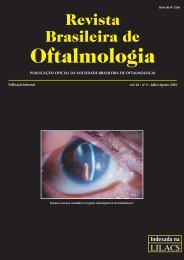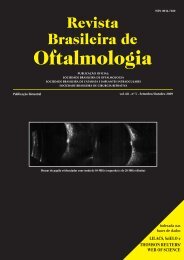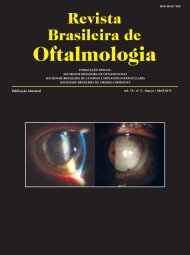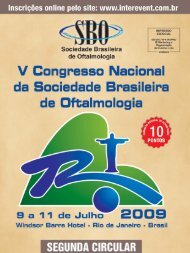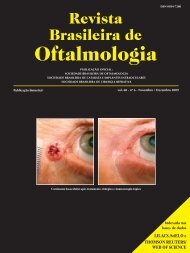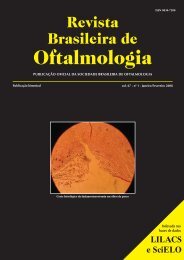Baixe aqui a versão em PDF da RBO - Sociedade Brasileira de ...
Baixe aqui a versão em PDF da RBO - Sociedade Brasileira de ...
Baixe aqui a versão em PDF da RBO - Sociedade Brasileira de ...
- No tags were found...
Create successful ePaper yourself
Turn your PDF publications into a flip-book with our unique Google optimized e-Paper software.
Fluência do laser e t<strong>em</strong>po <strong>de</strong> para<strong>da</strong> cirúrgica, por per<strong>da</strong> <strong>de</strong> fixação, como fatores relacionados à precisão refracional115fator que colaborou para a per<strong>da</strong> <strong>de</strong> linhas <strong>de</strong> visão foram asestrias, presentes <strong>de</strong> forma leve <strong>em</strong> 3,0% dos olhos operados.Houve também, como <strong>em</strong> outros trabalhos (18,19) , ganho <strong>de</strong>uma linha <strong>de</strong> visão <strong>em</strong> 11,5% dos olhos, <strong>em</strong> relação à AV comcorreção pré-operatório. O achado aconteceu mais nos míopes,s<strong>em</strong> privilegiar magnitu<strong>de</strong> <strong>de</strong> grau. A evolução <strong>da</strong>s máquinas paraaplicação do laser t<strong>em</strong> avançado muito nos últimos anos, assimcomo o aperfeiçoamento do tamanho i<strong>de</strong>al do spot. Esse últimov<strong>em</strong> diminuindo <strong>de</strong> tamanho, aumentando a precisão e tornandoseimportante também na melhora <strong>da</strong> quali<strong>da</strong><strong>de</strong> visual.Mesmo com a nota<strong>da</strong> precisão dos aparelhos <strong>de</strong> laser, apossibili<strong>da</strong><strong>de</strong> <strong>de</strong> hipo ou hipercorreções <strong>de</strong>v<strong>em</strong> ser esclareci<strong>da</strong>saos possíveis candi<strong>da</strong>tos. Apesar <strong>da</strong> irreversibili<strong>da</strong><strong>de</strong>, pequenosajustes pod<strong>em</strong> ser feito, após o terceiro mês <strong>de</strong> pós-operatório,levantando-se o disco corneano e realizando a foto-ablação (7,20,21) .Nesse trabalho, como na literatura (7,12,13,18,19) , nota-se boa precisãopara correção <strong>de</strong> qualquer tipo e magnitu<strong>de</strong> <strong>de</strong> ametropias,<strong>de</strong>s<strong>de</strong> que se faça o ajuste pelo nomograma (Quadro 1). Comparando-seo equivalente esférico pré e pós-operatório, nota-seóbvia diferença entre os dois momentos (p= 0,000), com médiapré-operatória <strong>de</strong> -4,09 e pós-operatória <strong>de</strong> -0,04.A fluência do laser reflete a quanti<strong>da</strong><strong>de</strong> <strong>de</strong> energia porárea <strong>em</strong> um único pulso, havendo uma relação direta com a quanti<strong>da</strong><strong>de</strong><strong>de</strong> tecido estromal ablado (22) . Se a fluência for acima dopadrão preconizado acontecerá hipercorreção, caso contrário ahipocorreção é espera<strong>da</strong>. Nesse estudo, apesar <strong>da</strong>s oscilaçõesdiárias observa<strong>da</strong>s (mínima <strong>de</strong> 0,513 e máxima <strong>de</strong> 0,581 mJ/cm 2 ),não se percebeu correlação (r= -0,03266; IC 95% -0,241 a 0,178;p= 0,762) entre a fluência apresenta<strong>da</strong> e o EE final dos olhosoperados (Figura 3).O estroma <strong>da</strong> córnea hidratado apresenta lamelas maisdistantes, com absorção <strong>de</strong> água pelas proteoglicanas constituintes.Tal rearranjo, com modificação intrínseca <strong>da</strong> matrizextracelular, po<strong>de</strong> alterar a taxa <strong>de</strong> ablação corneana, per<strong>de</strong>ndo-seenergia com <strong>de</strong>struição <strong>de</strong> água. A <strong>de</strong>sidratação por outrolado, <strong>de</strong>ve compactar mais as lamelas, po<strong>de</strong>ndo potencializar otratamento (23) . Sendo assim, as para<strong>da</strong>s transoperatórias, porper<strong>da</strong> <strong>de</strong> fixação do indivíduo, com maior exposição do leitoestromal ao ambiente levaria a um ressecamento e consequentehipercorreções. Nesse estudo o t<strong>em</strong>po mínimo <strong>de</strong> para<strong>da</strong> foi <strong>de</strong>dois segundos e o máximo <strong>de</strong> 12 segundos. Segundo figura 4, nãohá uma correlação (r= 0,08865; IC 95%= -0,123 a 0,293; p=0,411) entre o t<strong>em</strong>po <strong>de</strong> para<strong>da</strong> transoperatória e o EE.Esse estudo envolveu somente uma marca específica <strong>de</strong>laser e os resultados <strong>de</strong>v<strong>em</strong> restringir-se ao mo<strong>de</strong>lo estu<strong>da</strong>do.CONCLUSÃONão houve correlações entre as variações <strong>de</strong> fluência dolaser e o t<strong>em</strong>po <strong>de</strong> para<strong>da</strong> transoperatória, por per<strong>da</strong> <strong>de</strong> fixação,com hiper ou hipocorreções <strong>da</strong>s ametropias pós-Lasik.Agra<strong>de</strong>cimentos: Dr. André Messias (USP- FMRP)REFERÊNCIAS1. Maiman TH. Simulated optical radiation in ruby. Nature.1960;187(4736):493-4.2. Pallikaris IG, Papatzanaki ME, Stathi EZ, Frenschock O, GeorgiadisA. Laser in situ keratomileusis. Lasers Surg Med. 1990;10(5):463-8.3. McDonnell PJ. Refractive surgery. Br J Ophthalmol. 1999;83(11):1257-60.4. Kwitko S, Marinho D, Raskin R, Sprinz S, Rabin M, Rymer S, et al.Lasik para correção <strong>de</strong> miopia, astigmatismos e hipermetropia. ArqBras Oftalmol. 2000;63(1):9-18.5. Condon PI, Mulhern M, Fulcher T, Foley-Nolan A, O’Keefe M. Laserintrastromal keratomileusis for high myopia and myopic astigmatism.Br J Ophthalmol. 1997;81(3):199-206.6. Vieira Netto M, Ambrósio Jr R, Chalita MR, Krueger RR, Wilson SE.Resposta cicatricial corneana <strong>em</strong> diferentes mo<strong>da</strong>li<strong>da</strong><strong>de</strong>s <strong>de</strong> cirurgiarefrativa. Arq Bras Oftalmol. 2005;68(1):140-9.7. Pérez-Santoja JJ, Bellot J, Claramonte P, Ismail MM, Alió JL. Laser insitu keratomileusis to correct high myopia. J Cataract Refract Surg.1997;23(3):372-85.8. Marinho A, Pinto MC, Pinto R, Vaz F, Neves MC. LASIK for highmyopia: one year experience. Ophthalmic Surg Lasers. 1996;27(5Suppl):S517-20.9. Helmy SA, Salah A, Ba<strong>da</strong>wy TT, Sidky AN. Photorefractive keratectomyand laser in situ keratomileusis for myopia between 6.00 and10.00 diopters. J Refract Surg. 1996;12(3):417-21.10. Leoratti MC, Zampar HV, Costa C, Campos M. Study of ocular aberrationsand aging. In: Refractive Surgery Subspecialty Day, 2006. LasVegas, USA: American Acad<strong>em</strong>y of Ophthalmology; 2006.11. Doughty MJ, Laiquzzaman M, Müller A, Oblak E, Button NF. Centralcorneal thickness in European (white) individuals, especially childrenand the el<strong>de</strong>rly, and assessment of its possible importance in clinicalmeasures of intra-ocular pressure. Ophthalmic Physiol Opt.2002;22(6):491-504.12. Tsai RJ. Laser in situ keratomileusis for myopia of -2 to -25 diopters. JRefract Surg. 1997;13(5 Suppl):S427-9.13. Ojeimi G, Waked N. Laser in situ keratomileusis for hyperopia. J RefractSurg. 1997;13(5 Suppl):S432-3.14. Nunes LM, Francesconi CM, Campos M, Schor P. Resultados a curtoprazo <strong>de</strong> ceratotomia lamelar pedicula<strong>da</strong> (LASIK) para correção <strong>de</strong>hipermetropia com o sist<strong>em</strong>a La<strong>da</strong>r Vision <strong>de</strong> excimer laser. Arq BrasOftalmol. 2004;67(1):59-64.15. Salz JJ, Stevens CA; LADARVision LASIK Hyperopia Study Group.LASIK correction of spherical hyperopia, hyperopic astigmatism, andmixed astigmatism with the LADARVision excimer laser syst<strong>em</strong>.Ophthalmology. 2002;109(9):1647-56; discussion 1657-8. Comment inOphthalmology. 2003;110(12):2432-3; author reply 2433.16. McDonald MB, Carr JD, Frantz JM, Kozarsky AM, Maguen E, NesburnAB, et al. Laser in situ keratomileusis for myopia up to -11 diopterswith up to -5 diopters of astigmatism with the summit autonomousLADARVision excimer laser syst<strong>em</strong>. Ophthalmology.2001;108(2):309-16.17. Tsai YY, Lin JM. Ablation centration after active eye-tracker-assistedphotorefractive keratectomy and laser in situ keratomileusis. J CataractRefract Surg. 2000;26(1):28-34.18. Hersh PS, Brint SF, Maloney RK, Durrie DS, Gordon M, MichelsonMA, et al. Photorefractive keratectomy versus laser in situkeratomileusis for mo<strong>de</strong>rate to high myopia. A randomized prospectivestudy. Ophthalmology. 1998;105(8):1512-22, discussion 1522-3.Comment in Ophthalmology. 1998; 105(8):1357-8. Comment on Ophthalmology.1998;105(8):1357-8.19. Bas AM, Onnis R. Excimer laser in situ keratomileusis for myopia. JRefract Surg. 1995;11(3 Suppl):S229-33.20. Knorz MC, Wiesinger B, Liermann A, Seiberth V, Liesenhoff H. Laserin situ keratomileusis for mo<strong>de</strong>rate and high myopia and myopic astigmatism.Ophthalmology. 1998;105(5):932-40.21. Martines E, John ME. The Martines enhanc<strong>em</strong>ent technique for correctingresidual myopia following laser assisted in situ keratomileusis.Ophthalmic Surg Lasers. 1996;27(5 Suppl):S512-6.22. Rodrigues PD, Dimantas M, Chamon W. Lasers <strong>em</strong> cirurgia refrativa:aspectos básicos do excimer laser. In: Alves MR, Chamon W, Nosé W,editores. Cirurgia refrativa. Rio <strong>de</strong> Janeiro: Cultura médica; 2003. p. 67.23. Suzuki CK, Mori ES, Allermann N, Schor P, Campos M, Chamon W.Ceratectomia fotorrefrativa associa<strong>da</strong> à ceratotomia lamelarpedicula<strong>da</strong> (LASIK) para correção <strong>de</strong> miopias, com ou s<strong>em</strong> secag<strong>em</strong>do estroma. Arq Bras Oftalmol. 2000;63(6):449-53.Autor correspon<strong>de</strong>nte:Abrahão <strong>da</strong> Rocha LucenaAv. Santos Dumont, nº 5.753 - Torre Saú<strong>de</strong> - 15º an<strong>da</strong>rComplexo São Mateus – PapicuCEP 60822-131– Fortaleza (CE), BrasilE-mail: abrahaorlucena@gmail.comRev Bras Oftalmol. 2013; 72 (2): 112-5



